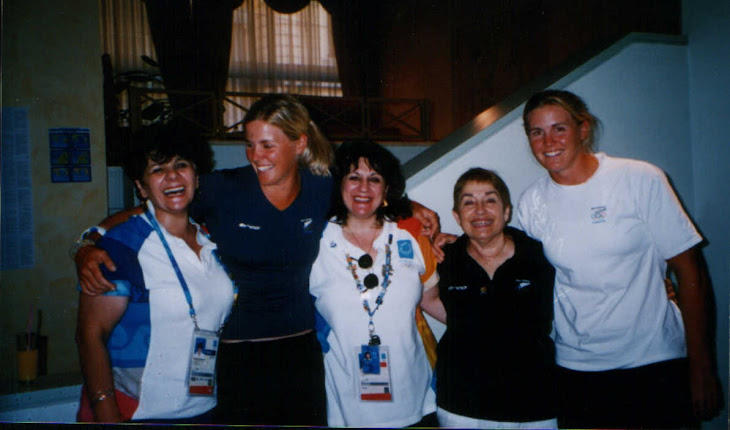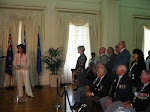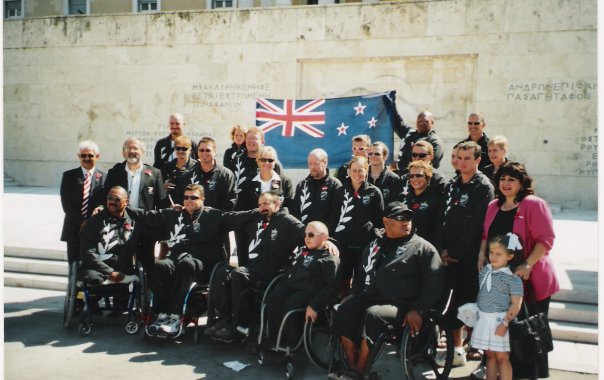Thursday, 18 November 2010
Thursday, 22 April 2010
ANZAC Day 2010 in Greece - LEST WE FORGET...
Lest we forget....
They shall grow not old....as we that are left grow old
Age shall not weary them, nor the years condemn
At the going down of the sun, and in the morning,
We will remember them,We will remember them...
Australia New Zealand Army Corps
Lest we forget....
Let's all be there, as we are every year, to honour the memory of those valiant young men who came to the other side of the world to fight , not just in World War I but in World War II as well, so that we could be free.
Hellenic New Zealand Association,
Athens, Greece
ANZAC Day
Anzac Day marks the anniversary of the first major military action fought by Australian and New Zealand forces during the First World War, and is held every year on April 25th.
The Gallipoli campaign
In 1915, Australian and New Zealand soldiers formed part of an Allied expedition that set out to capture the Gallipoli Peninsula, under a plan to open the way to the Black Sea for the Allies. The objective was to capture Istanbul, the capital of the Ottoman Empire and an ally of Germany
The ANZAC force landed at Gallipoli on 25 April, meeting fierce resistance from the Turkish Army commanded by Ataturk. What had been planned as a bold strike to knock Turkey out of the war quickly became a stale-mate, and the campaign dragged on for eight months. At the end of 1915, the Allied forces were evacuated after both sides had suffered heavy casualties and endured great hardships. Over 8,000 Australian and 2,700 New Zealand soldiers died. News of the landing at Gallipoli made a profound impact on Australians and New Zealanders at home and 25 April quickly became the day on which they remembered the sacrifice of those who had died in war.
Though the Gallipoli campaign failed in its military objectives of capturing Istanbul and knocking Turkey out of the war, the Australian and New Zealand troops' actions during the campaign bequeathed an intangible but powerful legacy. The creation of what became known as an ANZAC Legend became an important part of the national identity in both countries, shaping the ways their citizens viewed both their past and their future.
Read More at Wikipedia
ANZAC Biscuits
To learn how to make traditional ANZAC biscuits, see previous post!
They shall grow not old....as we that are left grow old
Age shall not weary them, nor the years condemn
At the going down of the sun, and in the morning,
We will remember them,We will remember them...
Australia New Zealand Army Corps
Lest we forget....
The Australian Embassy has invited New Zealanders and Australians and friends of both countries to attend the ANZAC Day Commemorative Celebrations
on
Sunday 25 April 2010, 11.00 a.m.
at
The Commonwealth War Cemetery
in
Alimos
(Posidonos Avenue and Ethnarhou Makariou Street)
on
Sunday 25 April 2010, 11.00 a.m.
at
The Commonwealth War Cemetery
in
Alimos
(Posidonos Avenue and Ethnarhou Makariou Street)
Let's all be there, as we are every year, to honour the memory of those valiant young men who came to the other side of the world to fight , not just in World War I but in World War II as well, so that we could be free.
Hellenic New Zealand Association,
Athens, Greece
ANZAC Day
Anzac Day marks the anniversary of the first major military action fought by Australian and New Zealand forces during the First World War, and is held every year on April 25th.
The Gallipoli campaign
In 1915, Australian and New Zealand soldiers formed part of an Allied expedition that set out to capture the Gallipoli Peninsula, under a plan to open the way to the Black Sea for the Allies. The objective was to capture Istanbul, the capital of the Ottoman Empire and an ally of Germany
The ANZAC force landed at Gallipoli on 25 April, meeting fierce resistance from the Turkish Army commanded by Ataturk. What had been planned as a bold strike to knock Turkey out of the war quickly became a stale-mate, and the campaign dragged on for eight months. At the end of 1915, the Allied forces were evacuated after both sides had suffered heavy casualties and endured great hardships. Over 8,000 Australian and 2,700 New Zealand soldiers died. News of the landing at Gallipoli made a profound impact on Australians and New Zealanders at home and 25 April quickly became the day on which they remembered the sacrifice of those who had died in war.
Though the Gallipoli campaign failed in its military objectives of capturing Istanbul and knocking Turkey out of the war, the Australian and New Zealand troops' actions during the campaign bequeathed an intangible but powerful legacy. The creation of what became known as an ANZAC Legend became an important part of the national identity in both countries, shaping the ways their citizens viewed both their past and their future.
Read More at Wikipedia
ANZAC Biscuits
To learn how to make traditional ANZAC biscuits, see previous post!
ANZAC Day in Athens...and ANZAC Biscuits!
Athens put on it's best weather for ANZAC Day last year! We had all gathered at the Alimos Commonwealth War Cemetery to take part in the annual ANZAC Day celebrations, a very moving experience for all concerned.
After the ANZAC Day ceremony in Athens, we (my 9 year-old Anastasia and I) decided to make a batch of Allyson Gofton's Anzac Biscuits.... I had written the post but forgotten to post...sorry for the delay, but it's just in time for this year. See you all on Sunday!
"My Dad was a 'Digger' and proud of it, and the one thing that best recalls that time when we all pulled together is the Anzac biscuit, created with love by mums and daughters to send to their sons and fathers at the Front." - Allyson Gofton
A good friend from Wellington sent me the recipe just for the occasion! Thanks Gina - they are as good as we remember them...even without Golden Syrup. Incidentally, I have yet to find the equivalent in Greece...I used honey, but any suggestions welcome!
This recipe makes about 36. Preparation time: 15 minutes. Cooking time: 12-15 minutes
Ingredients:
1 cup flour,
1 cup sugar
1 cup rolled oats
1 cup desiccated coconut
175 grams butter
2 tablespoons golden syrup
1 teaspoon vanilla essence
1 teaspoon baking soda,
2 tablespoons boiling water
Preheat the oven to 180C. Lightly grease 1 or 2 baking trays or line with baking paper. In a large bowl, sift flour with a good pinch of salt. Stir in the sugar, rolled oats and coconut and make a well in the centre.
In a saucepan, melt the butter, golden syrup and vanilla essence together.
After the ANZAC Day ceremony in Athens, we (my 9 year-old Anastasia and I) decided to make a batch of Allyson Gofton's Anzac Biscuits.... I had written the post but forgotten to post...sorry for the delay, but it's just in time for this year. See you all on Sunday!
"My Dad was a 'Digger' and proud of it, and the one thing that best recalls that time when we all pulled together is the Anzac biscuit, created with love by mums and daughters to send to their sons and fathers at the Front." - Allyson Gofton
A good friend from Wellington sent me the recipe just for the occasion! Thanks Gina - they are as good as we remember them...even without Golden Syrup. Incidentally, I have yet to find the equivalent in Greece...I used honey, but any suggestions welcome!
This recipe makes about 36. Preparation time: 15 minutes. Cooking time: 12-15 minutes
Ingredients:
1 cup flour,
1 cup sugar
1 cup rolled oats
1 cup desiccated coconut
175 grams butter
2 tablespoons golden syrup
1 teaspoon vanilla essence
1 teaspoon baking soda,
2 tablespoons boiling water
Preheat the oven to 180C. Lightly grease 1 or 2 baking trays or line with baking paper. In a large bowl, sift flour with a good pinch of salt. Stir in the sugar, rolled oats and coconut and make a well in the centre.
In a saucepan, melt the butter, golden syrup and vanilla essence together.
Dissolve the baking soda in the boiling water. Mix into the melted butter and quickly pour into the well. Mix all ingredients together quickly. Roll tablespoonfuls of the mixture into balls and place on the prepared trays. Flatten with the tines of a floured fork. Bake in the preheated oven for 12 to 15 minutes until the biscuits have flattened out and have become a reddish-brown colour. Transfer to a cake rack. They will crispen as they cool. Store in an airtight container.
To make chocolate Anzacs, melt 150 grams dark chocolate either in the microwave or over the top of a double saucepan. Dip half an Anzac into the melted chocolate and allow the excess to fall off.
Place on a baking paper-lined tray and allow the chocolate to set before storing in an airtight container.
To make chocolate Anzacs, melt 150 grams dark chocolate either in the microwave or over the top of a double saucepan. Dip half an Anzac into the melted chocolate and allow the excess to fall off.
Place on a baking paper-lined tray and allow the chocolate to set before storing in an airtight container.
Saturday, 6 February 2010
February 6, 2010 - Happy Waitangi Day to All New Zealanders!!!
-->
Happy Waitangi Day everyone!
I thought I would share with you all some of my Treaty of Waitangi pictures from the permanent exhibit at Wellington's Te Papa Museum, taken during my recent trip to New Zealand
The Treaty of Waitangi (Māori: Te Tiriti o Waitangi) is a treaty frst signed on February 6, 1840, by representatives of the British Crown, and various Māori chiefs from the northern North Island of New Zealand. The Treaty established a British governor in New Zealand Britain sovereignty over New Zealand New Zealand
Until the 1970s, the Treaty was generally ignored by both the courts and parliament, although it was usually depicted in New Zealand
Today it is generally considered the founding document of New Zealand
Click here to read more from Wikipedia.
See how much you know about the Treaty of Waitangi...
Take the Treaty of Waitangi Quiz (Source: NZ History on line)
 King, Marcus 1891-1977 :The signing of the Treaty of Waitangi, Feb 6th, 1840 [Wellington, Free Lance] 1939
King, Marcus 1891-1977 :The signing of the Treaty of Waitangi, Feb 6th, 1840 [Wellington, Free Lance] 1939
Representatives of the government and of the Māoris assembled at James Busby's residence, including Captain William Hobson. Henry Williams at the lower table explaining the text to a signatory, Captain J Nias, James Busby and Tamati Waka Nene.
Click here to see original at the Alexander Turnbull Library, National Library of New Zealand,
Te Puna Matauranga O Aotearoa
Te Puna Matauranga O Aotearoa
Subscribe to:
Comments (Atom)



























